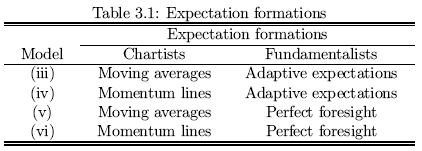The theoretical contribution of this paper is found in the way in which the portfolio managers weight the expectations of chartists and fundamentalists. This consists of explicitly modelling the empirical observation that the relative importance of technical versus fundamental analysis in the foreign exchange market depends on the forecasting horizon.
For shorter forecasting horizons, more weight is placed on technical analysis, while the opposite is true for longer forecasting horizons (Taylor and Allen, 1992). Furthermore, it is assumed that the forecasting horizon depends
inversely on domestic inflation rate, i. e. the forecasting horizon is infinite if domestic prices are "stable", and myopic if domestic prices are "unstable". Hence, it is assumed that macroeconomic fundamental analysis dominates if domestic inflation rate is low, while technical analysis dominates if domestic inflation rate is high.
Technical analysis also dominates if domestic deflation rate is high. Thus, referring to eq. (3.2) above, the expectations for the portfolio managers can be written as

where  is the domestic inflation rate.
is the domestic inflation rate.
The theoretical framework in this paper is the Dornbusch (1976) overshooting
model. The main assumptions of this model can be summarized as follows: (1) the economy is permanently fully employed, which implies that fluctuations in demands for goods only result in price movements, not in output movements; (2) goods prices are sticky in the short-run, i.e. they need time to react to and absorb fluctuations in goods demand; and (3) the domestic interest rate and the exchange rate are perfectly flexible, which implies that the monetary sector is in permanent equilibrium.
The stickiness of goods prices is the reason for the overshooting phenomenon, i. e. the exchange rate overshoots its long-run equilibrium in the short-run because it restricts prices from making their required contribution to overall adjustment.
The Dornbusch (1976) overshooting model is simple and has a number of shortcomings, e.g. economic policy is treated exogenously and the economy is represented in an ad hoc fashion without an explicit microeconomic foundation. Despite these shortcomings, the Dornbusch (1976) overshooting model is used as the theoretical framework in this paper for two reasons.
First, this model is suitable because nominal exchange rates are volatile (Frankel and Rose, 1995). Second, for technical analysis to exist, the foreign exchange market must be inefficient. The assumption that goods prices are assumed to be sticky in the short-run means that inefficiency is a characterizing feature of this model.
The contributions in this paper consist of four models. In these models, the fundamentalists have either adaptive expectations or perfect foresight, and the chartists use either moving averages or momentum lines to form their expectations. The combinations of expectation formations for the chartists and the fundamentalists are given in Table 3.1.1

Three questions are in focus in the formal analysis of models (iii)-(vi).
First: are these models globally stable or is saddle path stability the characterizing feature?
Second: what are the stability conditions for these models?
Third: is the overshooting phenomenon robust with respect to the presence of chartists in these models?
Are models (iii)-(vi) globally stable or is saddle path stability the characterizing
feature? All models are characterized by saddle path stability although global stability is also possible in model (iii). In short, the more flexible the goods prices, the more likely it is that the model is globally stable.
What are the stability conditions for models (iii)-(vi)? When saddle path stability is the characterizing feature of model (iii), the stability condition is that the economy must continuously be in equilibrium. This is also the stability condition for models (iv)-(vi). Because the monetary sector is assumed to be in permanent equilibrium, this stability condition means that the real sector, i. e. the goods market, must also be in equilibrium, which is the case when the domestic inflation rate is zero.
This implies that the portfolio managers exclude the chartists when forming
their expectations about the future development of the exchange rate, which means that chartists have no influence on the foreign exchange market.
The stability condition that the economy must continuously be in equilibrium
can also be interpreted as suggesting that actual and expected inflation rates must be equal. As a consequence, if actual and expected inflation rates differ, the exchange rate will reach "infinity". Because the expected inflation rate is not a part of models (iii)-(vi), this conjecture forms a basis for further research.
Is the overshooting phenomenon robust with respect to the presence of chartists in models (iii)-(vi)? Yes, if the models are continuously in equilibrium as is the case in three of the models. The exception is model (iii) where global stability is possible.
In this model, the exchange rate may even move in the "wrong direction" after a monetary disturbance, i.e. the currency loses value after a contractionary monetary policy, if the domestic inflation rate is modest. However, if the domestic inflation rate is low, the level of overshooting of the exchange rate is greater than when the Dornbusch (1976) overshooting model holds.
In summary, an economic policy that stabilizes the inflation rate at a low level may destabilize the exchange rate through overshooting. This, however, is the "price" one has to pay to prevent the economy from "exploding". Though, the recommended policy of a low inflation rate should not be interpreted in favor of a policy that give priority to a fully employed economy, because the latter, i.e. a fully employed economy, has been an assumption in all models.
Prof. Mikael Bask
Next: Concluding remarks
Summary: Index